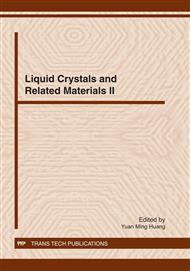[1]
J. H. Burroughes, D. D. C. Bradley, A. R. Brown et al.: Nature Vol. 347 (1990), p.539.
Google Scholar
[2]
R. H. Friend, R. W. Gymer, A. B. Holmes et al.: Nature Vol. 387 (1999), p.121.
Google Scholar
[3]
Y. M. Huang, W. Ge, J. W. Y. Lam et al.: Appl. Phys. Lett. Vol. 75 (1999), p.4094.
Google Scholar
[4]
M.Y. M. Huang, C. K. Law, W. Ge et al: J. Lumin. Vol. 99 (2002), p.161.
Google Scholar
[5]
Y. M. Huang and B. G. Zhai: Mol. Cryst. Liq. Cryst. Vol. 511 (2009), p.272.
Google Scholar
[6]
Y. M. Huang, F. Zhou and K. Xu: Appl. Phys. Lett. Vol. 88 (2006), p.131112.
Google Scholar
[7]
Y. M. Huang and B. -G. Zhai: Key Eng. Mater. Vol. 428-429 (2010), p.182.
Google Scholar
[8]
L. Akcelrud: Prog. Polym. Sci. Vol. 28 (2003), p.875.
Google Scholar
[9]
L. S. Hung and C.H. Chen: Mater. Sci. Eng. R Vol. 39 (2002), p.143.
Google Scholar
[10]
T. V. Vernitskaya and O. N. Efimov, Russian Chem. Rev. Vol. 66 (1997), p.443.
Google Scholar
[11]
Y. M. Huang, F. F. Zhou, B. G. Zhai et al.: Solid State Ion. Vol. 179 (2008), p.1194.
Google Scholar
[12]
B. -G. Zhai, Q. -L. Ma and Y. M. Huang: Mater. Sci. Forum Vol. 663-665 (2011), p.658.
Google Scholar
[13]
Y. M. Huang, B. -G. Zhai and Q. -L. Ma: Mater. Sci. Forum Vol. 663-665 (2011), p.300.
Google Scholar
[14]
Y. M. Huang and B. G. Zhai: Mol. Cryst. Liq. Cryst. Vol. 510 (2009), p.214.
Google Scholar
[15]
Y. M. Huang and B. G. Zhai: Mol. Cryst. Liq. Cryst. Vol. 511 (2009), p.272.
Google Scholar
[16]
Y. M. Huang, B. G. Zhai and F. F. Zhou: Mol. Cryst. Liq. Cryst. Vol. 510 (2009), p.34.
Google Scholar
[17]
Y. M. Huang, Y. Song, C. Huang et al.: J. Lumin. Vol. 114 (2005), p.241.
Google Scholar
[18]
Y. M. Huang and B. -G. Zhai: Key Eng. Mater. Vol. 428-429 (2010), p.212.
Google Scholar
[19]
Q. -L. Ma, R. Xiong, Y. M. Huang: J. Lumin. Vol. 131 (2011), p. (2053).
Google Scholar
[20]
B. -G. Zhai and Y. M. Huang: Key Eng. Mater. Vol. 428-429 (2010), p.288.
Google Scholar


